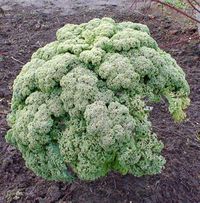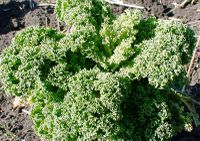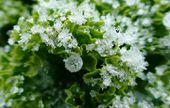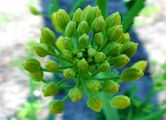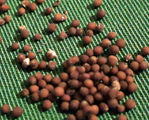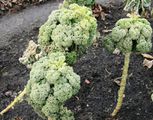Kale
Start a vegetable garden - Lesson 7: Kale
Kale was one of the most common vegetables in Europe already before the Middle Ages. Some varieties existed in ancient Greece.
Kale is an easy crop to cultivate and grows on most every soil. Sow preferably in April, not later than the end of June. You can sow in a row, or in pots, and plant out later.
Kale can tolerate shade quite well. You can plant them between crops that are going to be harvested in the summer. By the time that the kale plants get bigger, the other crops will be gone.
Kale tastes best when frost has been over it. If you harvest before it froze outside, you can freeze kale in the freezer. Kale usually withstands the hardest winters, although some leaves may be damaged by stronger frost. Kale grows out again in early spring until it begins to blossom around April. Let the plants flower for some time; bees like it.
Kale is very high in a number of vitamins, among them vitamin C. and is reasonably rich in calcium. Kale, contains sulforaphane, a chemical with potent anti-cancer properties. Boiling decreases the level of sulforaphane; however, steaming, microwaving, or stir frying do not result in significant loss.
Chunks of information
Cultivation instructions
See Kale, in Research Topics linking to several articles with cultivation instructions.
Planting kale late in the season
Last year i planted kale or borecole around September. That was a little late in the season but the plants still grew to reasonable size before frost set in. It was a cold winter but this sturdy plant survived several weeks of freezing temperatures. A bigger problem were wild rabbits who, when all the land was covered with snow, found my garden to be a nice storeroom. They ate most of the leaves but to my happy surprise the plants began growing new leaves in spring. In recent days the top leaves showed signs that the plants are preparing to make flowers. That's the end of harvest so i decided to take out all plants today except one that i'll keep for getting new seeds.
Today was harvest time. It is essential to keep as little time as possible between harvesting and consuming. I look at this mostly from an energy viewpoint. A fresh and healthy plant radiates good energy and i want to conserve that energy in the food and on my plate.
Before freezing in, i cook the kale until boiling point and then cool them as fast as possible before. The juices that come free are kept as ingredient for soup. Our bodies exist on an energy level too and to keep ourselves healthy we must regard the energy qualities of everything that we eat. There are many principles to be learned for this when cultivating a garden. In the kitchen it is important that all bad looking parts of the plants are taken out and thrown on the compost heap. Try to not only see what looks bad externally but also remove the leaves that don't 'shine.' When washing the leaves don't put them on a table that is also used for 'unclean' things such as newspapers or garbage etc. Keep a special table for preparing food only. This maintains the good energy of that table and place and prevents the good energy of vegetables to be contaminated. Keep the time between harvest and preparation of food as short as possible. One hour is much better than three hours and three hours is much better than one day.
Nutritious and medicinal properties
See Kale, in Research Topics linking to several articles about this topic.
Gallery
Kale after several weeks of frost.
See also
External links
- Kale Research Topics
- Kale "Kale is considered to be a highly nutritious vegetable with powerful antioxidant properties; kale is considered to be anti-inflammatory. Kale is very high in beta carotene, vitamin K, vitamin C, lutein, zeaxanthin, and reasonably rich in calcium. Kale, as with broccoli and other brassicas, contains sulforaphane (particularly when chopped or minced), a chemical believed to have potent anti-cancer properties." - Wikipedia
- Several recipes and info about kale

